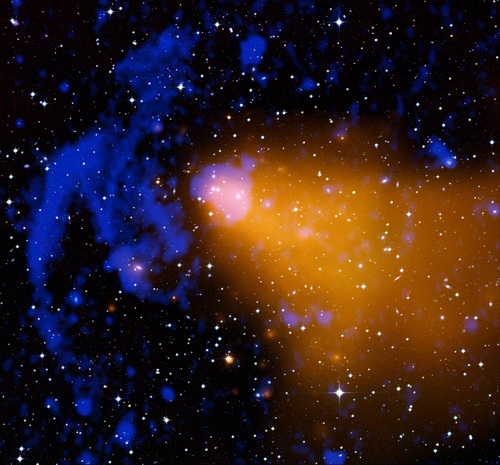The discovery that the universe’s expansion is accelerating has led some to wonder whether General Relativity breaks down at large scales. But new work by Fabian Schmidt and colleagues at Caltech seems to play down a rival theory known, economically enough, as f(R). If, under General Relativity, we see dark energy in terms of a cosmological constant, and thus view it as the energy of empty space, f(R) takes another tack, seeing the cosmic acceleration as the result of a necessary modification of gravitational theory. This effect would play a role in the way matter grows over time to become galaxy clusters, and that leads to a useful way to test the theory.
What Schmidt and team did was to take mass estimates of 49 galaxy clusters based on observations from the Chandra X-ray Observatory, comparing them with the predictions of theory and raw data from supernova studies, the cosmic microwave background and the large-scale distribution of galaxies. Compellingly, they found no difference in gravity as understood by General Relativity on scales larger than 130 million light years. Says Schmidt:
“This is the strongest ever constraint set on an alternative to General Relativity on such large distance scales. Our results show that we can probe gravity stringently on cosmological scales by using observations of galaxy clusters.”
In essence, the growth of galactic clusters is being used as a test of modified gravity scenarios at the largest levels, and may turn out to be useful in investigating alternate models growing out of string theory and other theories invoking higher dimensions. It’s helpful in this regard to see that a second, independent study tests gravity across cosmological distances. Tapping Chandra data along with observations from the ROSAT telescope, a team at Stanford University examined the growth of galaxy clusters to see how their evolution fits with the predictions of General Relativity. And for a second time, GR wins out, says David Rapetti (Kavli Institute for Particle Astrophysics and Cosmology), who led the study:
“Einstein’s theory succeeds again, this time in calculating how many massive clusters have formed under gravity’s pull over the last five billion years. Excitingly and reassuringly, our results are the most robust consistency test of General Relativity yet carried out on cosmological scales.”
Image: This composite image of the galaxy cluster Abell 3376 shows X-ray data from the Chandra X-ray Observatory and the ROSAT telescope in gold, an optical image from the Digitized Sky Survey in red, green and blue, and a radio image from the VLA in blue. The “bullet-like” appearance of the X-ray data is caused by a merger, as material flows into the galaxy cluster from the right side. The giant radio arcs on the left side of the image may be caused by shock waves generated by this merger. Credit: X-ray (NASA/CXC/SAO/A. Vikhlinin; ROSAT), Optical (DSS), Radio (NSF/NRAO/VLA/IUCAA/J.Bagchi).
Why are galaxy clusters so useful? Their growth is influenced by both the expansion rate of the universe and by the properties of gravity over large scales. Other methods, such as observing supernovae or the large-scale distribution of galaxies, help us to measure distances but are dependent only upon the expansion rate of the universe and not sensitive to the properties of gravity. It’s the growth rate of the cluster structure that these new studies work with, and that growth is driven by gravity, making the observations a telling indicator of how gravity operates at the cosmological level.
The first paper is Schmidt et al., “Cluster Constraints on f(R) Gravity,” Physical Review D 80, 083505 (2009). Preprint available, and abstract here. The second team’s paper has been accepted by Monthly Notices of the Royal Astronomical Society. See the preprint of Mantz et al., “The Observed Growth of Massive Galaxy Clusters 1: Statistical Methods and Cosmological Constraints,” with other papers in the series likewise available at the arXiv site. This Chandra news release is helpful.




So, speaking of confirmation, I am wondering if my understanding of the issues discussed in this post is correct. The cosmic acceleration in the context of General Relativity– which supposedly these cluster observations confirm– is caused by energy within empty space itself whereas the cosmic acceleration in the context of these alternative gravity theories, such as f(R) is NOT due to any extra energy with empty space itself. These two alternatives seem to me to be strikingly different scenarios; the fact that we are on the verge of distinguishing between via astronomical observations is exciting! Is this assessment correct?
Yes, f(R) modifies gravity at large scales to account for the observed acceleration of the universe’s expansion, and thus forces us to re-examine General Relativity and how it can be tweaked at these levels. A dark energy explanation consistent with General Relativity does not need these tweaks. That said, anyone more familiar than I am with f(R) should chime in — the above is my understanding, but a specialist’s viewpoint would be appreciated (I think I know just the guy, and will float this past him for comment).